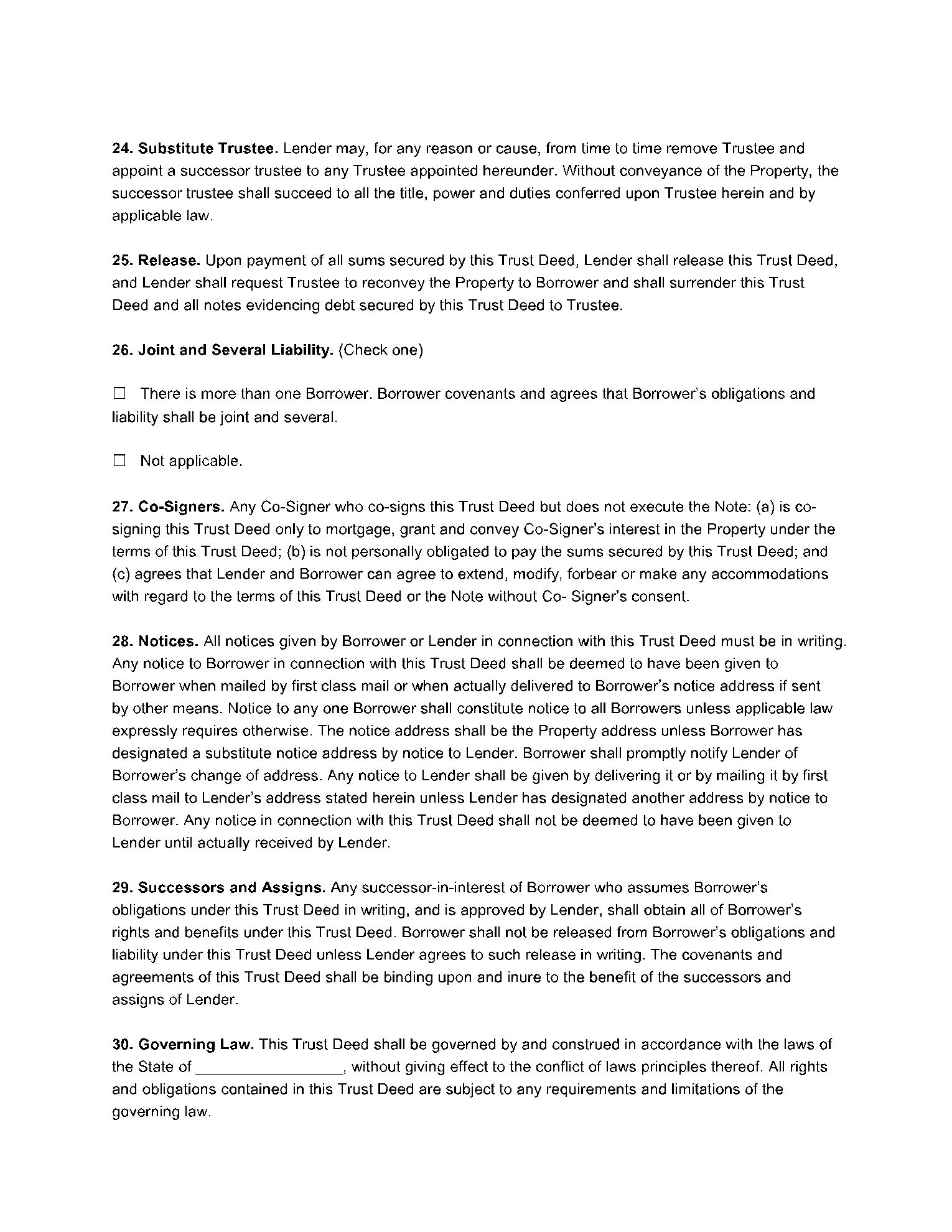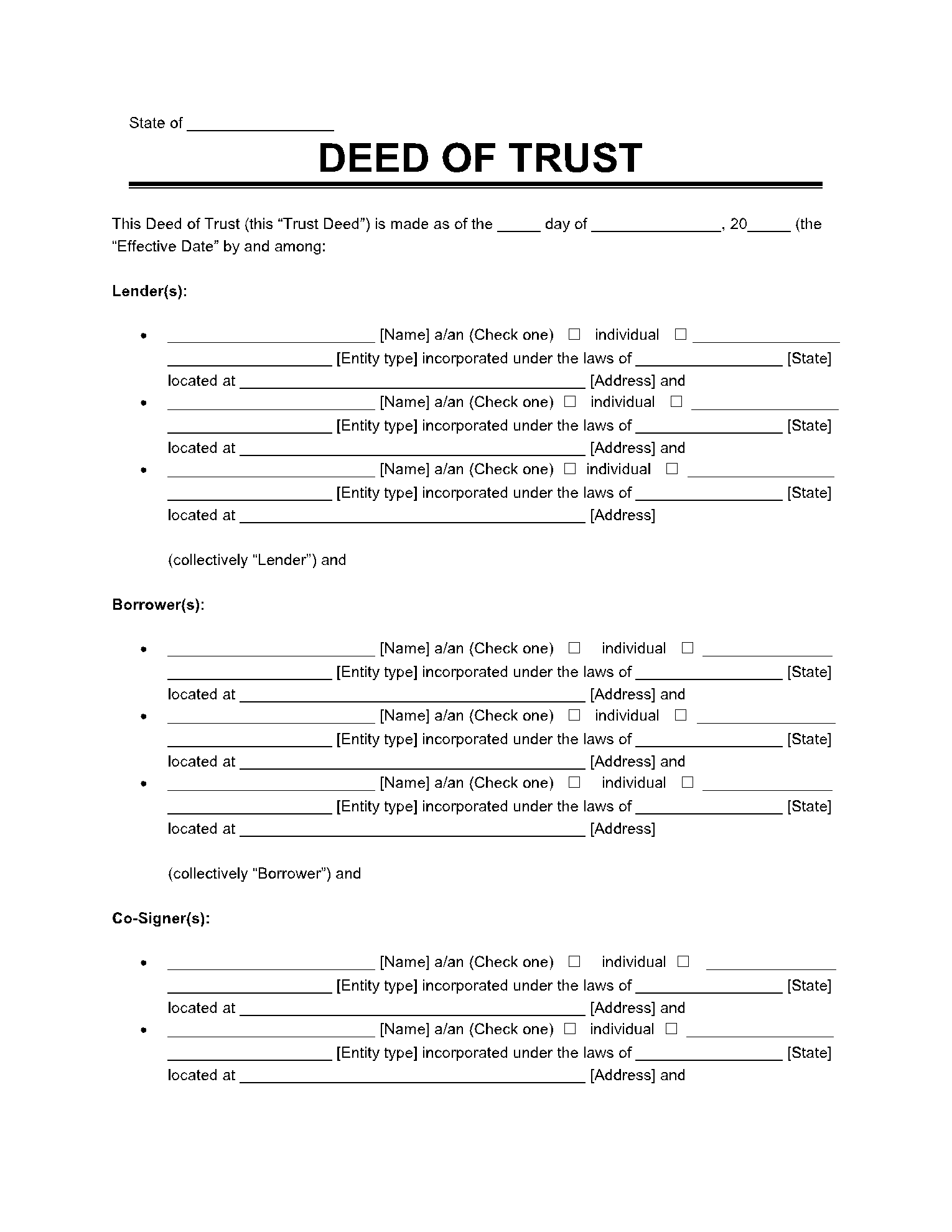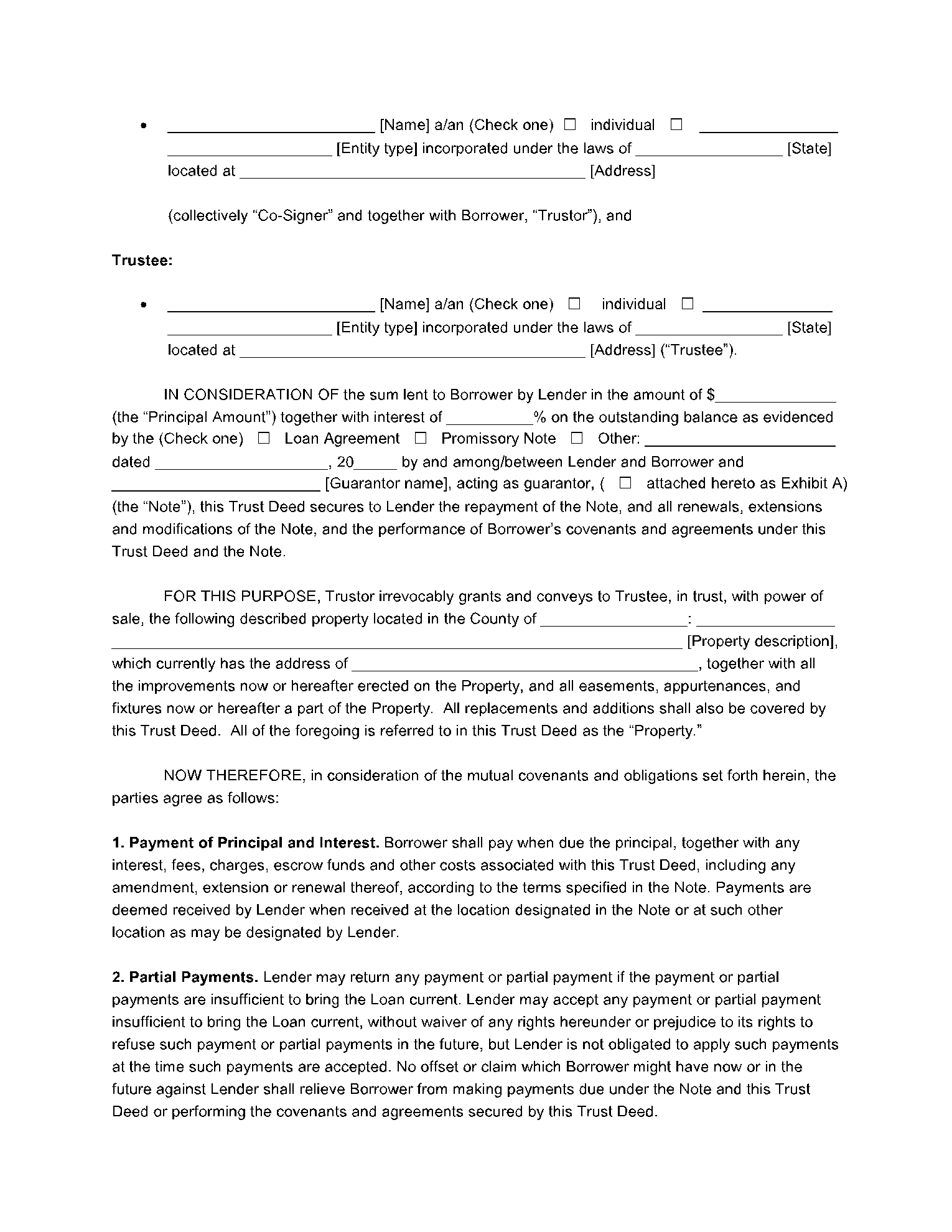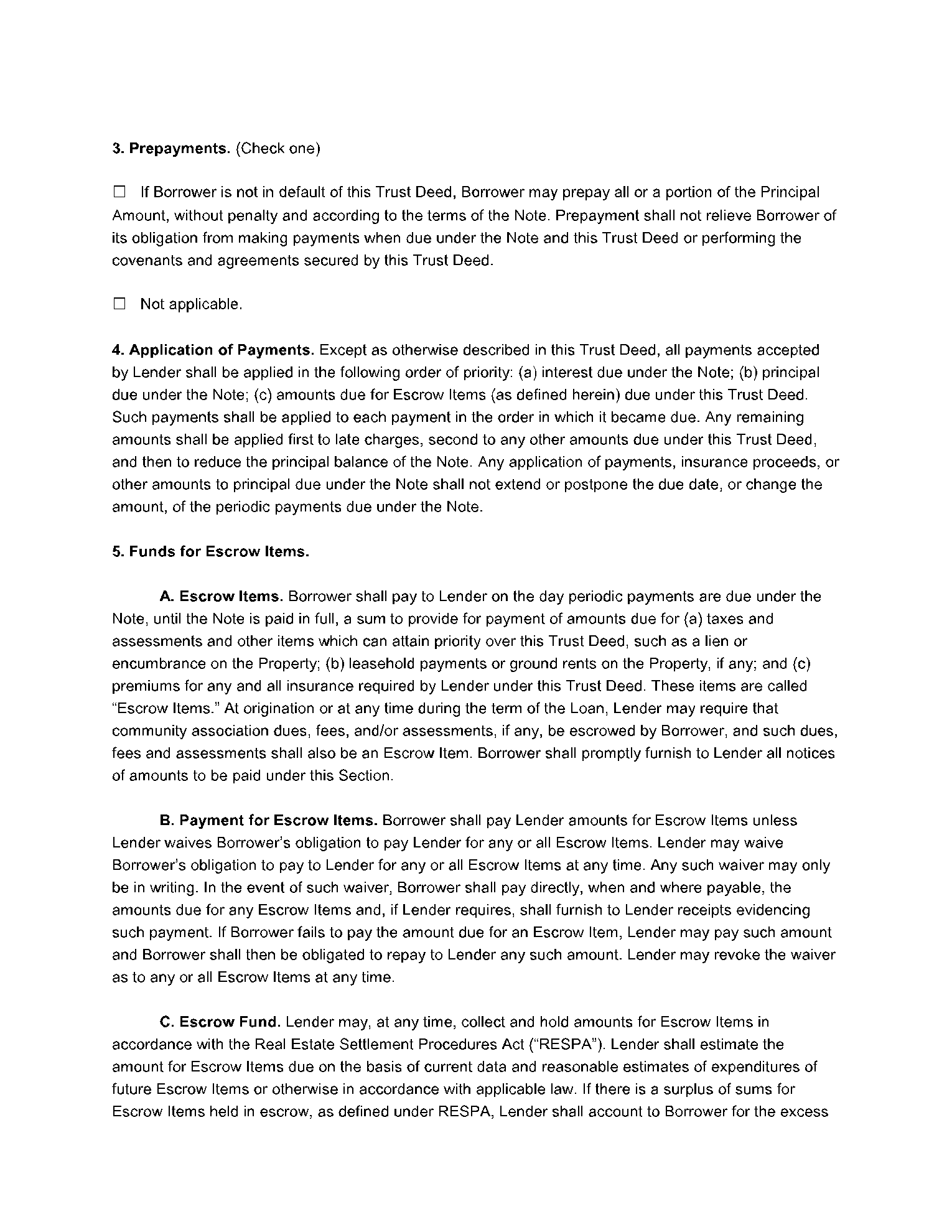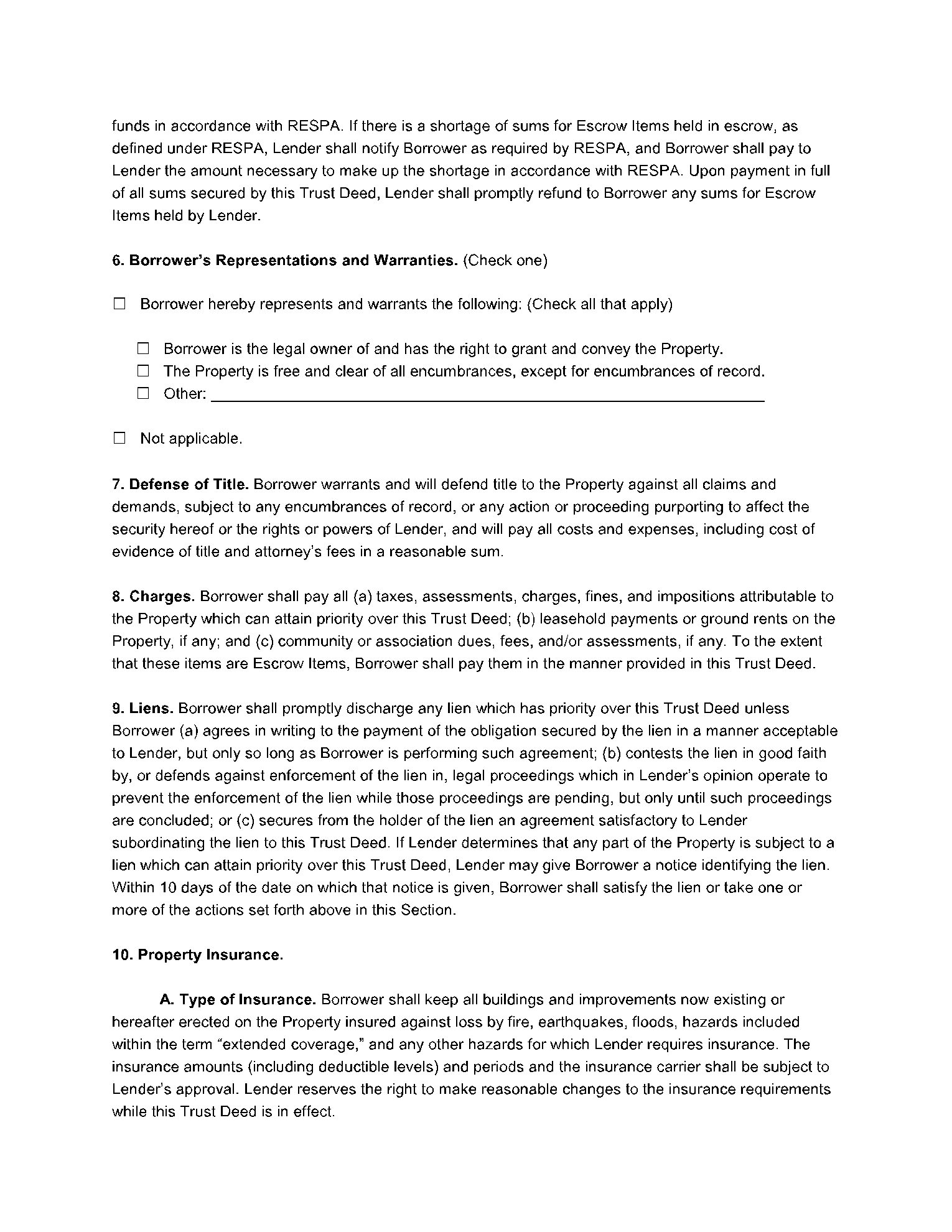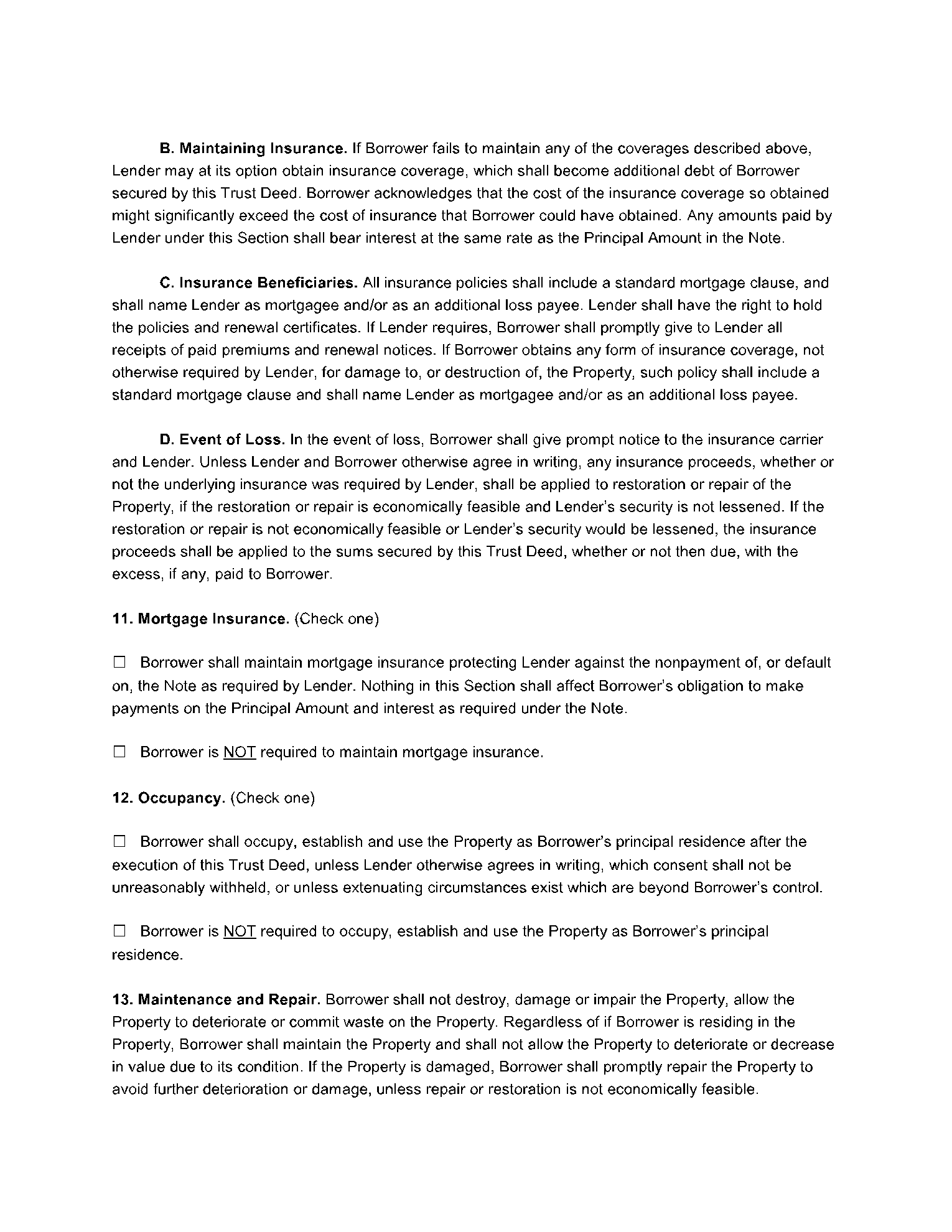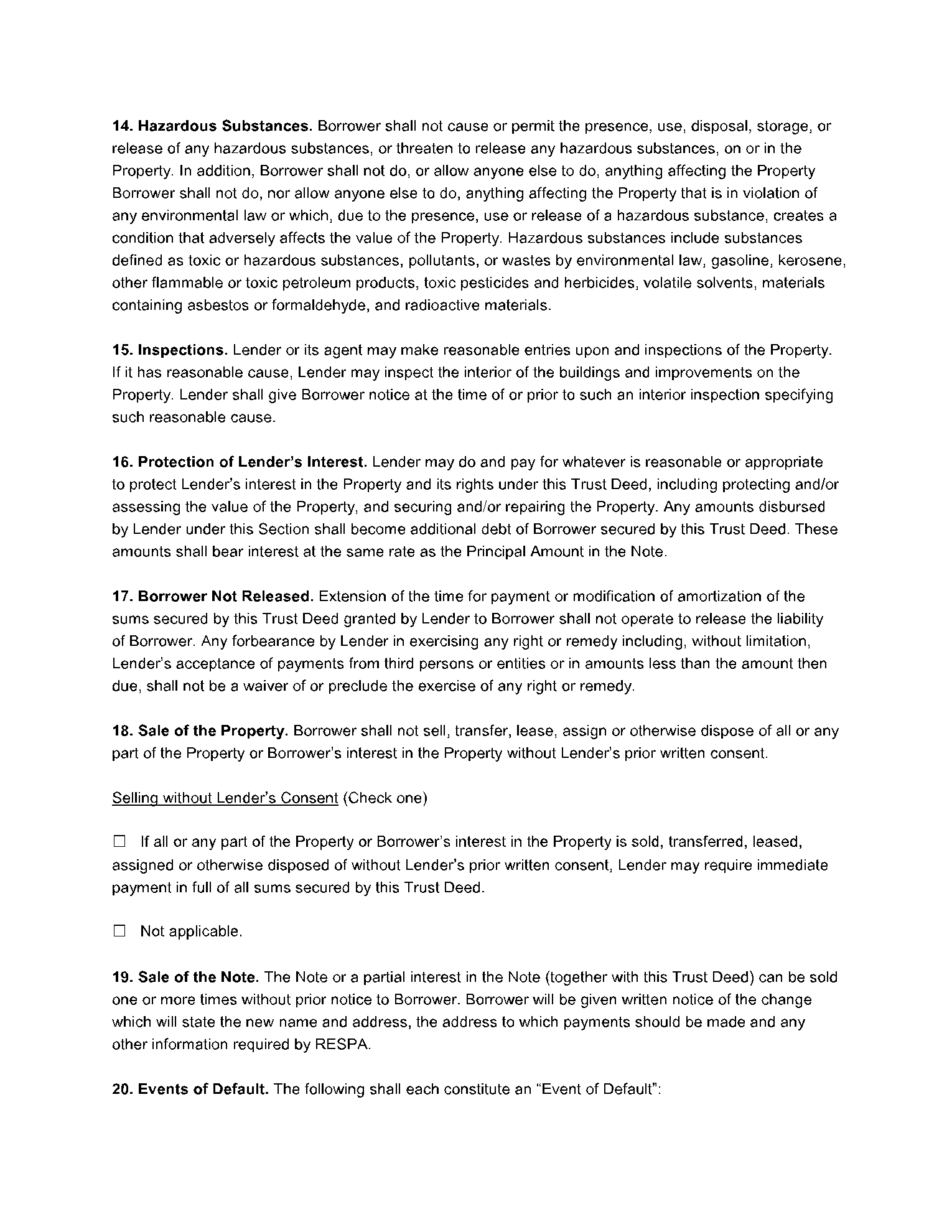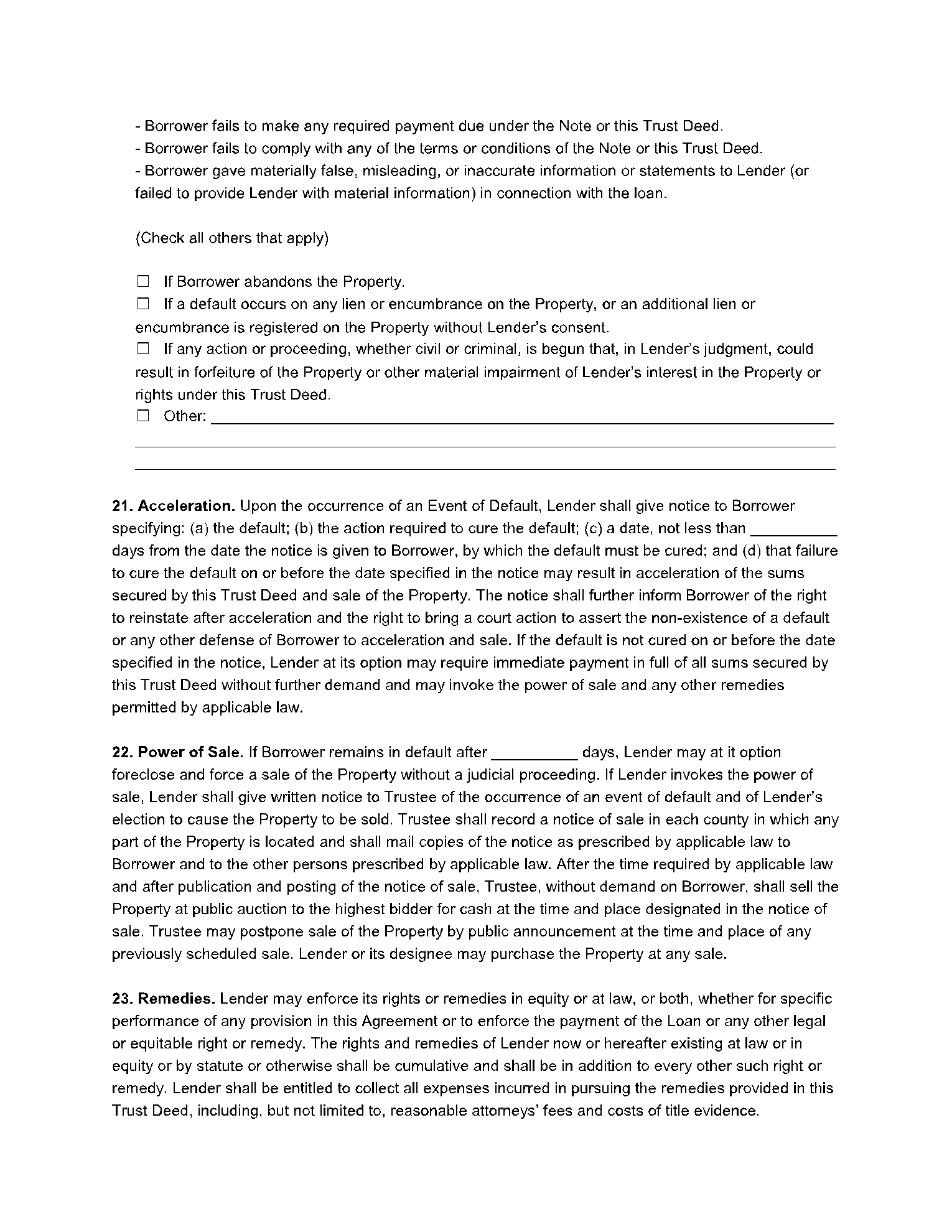A California deed of trust is very similar to a mortgage and quite different from other types of deeds used in the state of California. It’s not used to transfer ownership from one party to another, but rather to hold the property as collateral until the loan is paid off.
The deed of trust California form specifies that if the borrower, or landowner, doesn’t make the payments for the loan, the trustee is entitled to sell the property to pay the rest of the loan off. It’s written proof that until the last payment is made, the lender has an interest in that particular real estate property.
What Is a Deed of Trust in California?
The California deed of trust form is used when someone needs to get a loan and is the equivalent of a mortgage. Unlike the other deeds, the California deed of trust doesn’t transfer the property to a new owner; instead, the piece of real estate is held as security against the loan until the borrower makes all the payments.
Three parties are involved in California deeds of trust: the beneficiary, the borrower, and the trustee. The beneficiary is the lender, a person, or a company that grants the loan. The borrower is the owner of the property, which is used as collateral.
The trustee is a third party, usually a title or trust company, that holds the piece of real estate as collateral; if the borrower doesn’t pay back the loan, the trustee is entitled to sell the property and use the money to reimburse the beneficiary.
Carry Out Trusted Procedure With Our California Deed of Trust Form Template
Our deed of trust form California template is easy to understand and trustworthy. So, download the PDF format of the template and bid farewell to stress.
Click on the button below to get the template.
When and Why is a Deed of Trust Needed in California?
The state of California allows the use of a deed of trust instead of a mortgage, and as a result, the deed of trust form California is used quite frequently. When a person needs to get a loan, even if it is from a bank or other financing source, they can use a piece of real estate they own as a guarantee against the loan.
The fact is the deed of trust California is beneficial both for the borrower and the lender. The borrower knows that an impartial third party keeps their property as collateral and that they will have no problem getting it back once the loan is paid.
The beneficiary, on the other hand, has the certainty of receiving the money quickly in case the borrower cannot pay the installments. The advantage is that the trustee can sell the property and pay the lender without any court involvement. The California deed of trust gives them the right to sell and set the records straight.
The deed of trust form offers a simple and clear way of accessing loans if you own a piece of real estate that you can use as collateral, and at the same time of clearing the debt without the complications of a court trial.
Since a third party is involved, everything is clear and impartial. For all aspects to be crystal clear, the borrower also has to issue a promissory note and file it along with the deed of trust.
What Information Is Included in the California Deed of Trust Form?
The California deed of trust form is a very important document, given that it is written proof of how a loan and the collateral used to get it will be handled. Many essential aspects must be kept in mind when writing a deed of trust form.
It’s a document that helps the parties avoid a court trial, so all the information must be accurate and complete. It’s best to write it using the template we offer at CocoSign, but either way, these are the pieces of information that are mandatory in any California deed of trust:
- At the top part of the document, you must write the exact address where the deed must be sent after being recorded (that’s usually the address of the trustee); it’s a critical section, so make sure the address is valid
- The Assessor’s Parcel Number
- The effective date of the deed: the day, month, and year when the three parties enter the deed
- The identifying information of the debtor; that’s the person or business that owns the property and uses it as collateral to get a loan
- Trustor name
- The identifying information of the trustee, the company that will have authority over the real estate property until the loan is paid
- Mention what kind of entity the trustee is in the eyes of the government and the public
- The identifying information of the beneficiary, including the legal definition
- The location of the property used as collateral
- The legal description of the property
- Mention the sum of the loan
- Signatures of all parties involved
- A notary public handles the last part of the document and uses their state seal
Carry Out Trusted Procedure With Our California Deed of Trust Form Template
Our deed of trust form California template is easy to understand and trustworthy. So, download the PDF format of the template and bid farewell to stress.
Click on the button below to get the template.
Conclusion
Loans are easily contracted in the state of California using a deed of trust form that makes sure any future problem can be settled without court involvement. Since there are three parties involved and quite a lot of crucial information, the California deed of trust must be issued with a lot of care.
The best way to write it is with an efficient template, like the one we provide at CocoSign. You will find our deed of trust form, as well as all the other templates we offer, are user friendly and extremely useful.
DOCUMENT PREVIEW
-
________________________ [Name] a/an (Check one) ☐ individual ☐ ________________ ___________________ [Entity type] incorporated under the laws of _________________ [State] located at ________________________________________ [Address]
(collectively “Co-Signer” and together with Borrower, “Trustor”), and
Trustee:
-
________________________ [Name] a/an (Check one) ☐ individual ☐ _______________ ___________________ [Entity type] incorporated under the laws of _________________ [State] located at ________________________________________ [Address] (“Trustee”).
IN CONSIDERATION OF the sum lent to Borrower by Lender in the amount of $______________ (the “Principal Amount”) together with interest of __________% on the outstanding balance as evidenced by the (Check one) ☐ Loan Agreement ☐ Promissory Note ☐ Other: ______________________ dated ____________________, 20_____ by and among/between Lender and Borrower and ________________________ [Guarantor name], acting as guarantor, ( ☐ attached hereto as Exhibit A) (the “Note”), this Trust Deed secures to Lender the repayment of the Note, and all renewals, extensions and modifications of the Note, and the performance of Borrower’s covenants and agreements under this Trust Deed and the Note.
FOR THIS PURPOSE, Trustor irrevocably grants and conveys to Trustee, in trust, with power of sale, the following described property located in the County of _________________: ________________
__________________________________________________________________ [Property description], which currently has the address of ________________________________________, together with all the improvements now or hereafter erected on the Property, and all easements, appurtenances, and fixtures now or hereafter a part of the Property. All replacements and additions shall also be covered by this Trust Deed. All of the foregoing is referred to in this Trust Deed as the “Property.”
NOW THEREFORE, in consideration of the mutual covenants and obligations set forth herein, the parties agree as follows:
1. Payment of Principal and Interest. Borrower shall pay when due the principal, together with any interest, fees, charges, escrow funds and other costs associated with this Trust Deed, including any amendment, extension or renewal thereof, according to the terms specified in the Note. Payments are deemed received by Lender when received at the location designated in the Note or at such other location as may be designated by Lender.
2. Partial Payments. Lender may return any payment or partial payment if the payment or partial payments are insufficient to bring the Loan current. Lender may accept any payment or partial payment insufficient to bring the Loan current, without waiver of any rights hereunder or prejudice to its rights to refuse such payment or partial payments in the future, but Lender is not obligated to apply such payments at the time such payments are accepted. No offset or claim which Borrower might have now or in the future against Lender shall relieve Borrower from making payments due under the Note and this Trust Deed or performing the covenants and agreements secured by this Trust Deed.
3. Prepayments. (Check one)
☐ If Borrower is not in default of this Trust Deed, Borrower may prepay all or a portion of the Principal Amount, without penalty and according to the terms of the Note. Prepayment shall not relieve Borrower of its obligation from making payments when due under the Note and this Trust Deed or performing the covenants and agreements secured by this Trust Deed.
☐ Not applicable.
4. Application of Payments. Except as otherwise described in this Trust Deed, all payments accepted by Lender shall be applied in the following order of priority: (a) interest due under the Note; (b) principal due under the Note; (c) amounts due for Escrow Items (as defined herein) due under this Trust Deed. Such payments shall be applied to each payment in the order in which it became due. Any remaining amounts shall be applied first to late charges, second to any other amounts due under this Trust Deed, and then to reduce the principal balance of the Note. Any application of payments, insurance proceeds, or other amounts to principal due under the Note shall not extend or postpone the due date, or change the amount, of the periodic payments due under the Note.
5. Funds for Escrow Items.
A. Escrow Items. Borrower shall pay to Lender on the day periodic payments are due under the Note, until the Note is paid in full, a sum to provide for payment of amounts due for (a) taxes and assessments and other items which can attain priority over this Trust Deed, such as a lien or encumbrance on the Property; (b) leasehold payments or ground rents on the Property, if any; and (c) premiums for any and all insurance required by Lender under this Trust Deed. These items are called “Escrow Items.” At origination or at any time during the term of the Loan, Lender may require that community association dues, fees, and/or assessments, if any, be escrowed by Borrower, and such dues, fees and assessments shall also be an Escrow Item. Borrower shall promptly furnish to Lender all notices of amounts to be paid under this Section.
B. Payment for Escrow Items. Borrower shall pay Lender amounts for Escrow Items unless Lender waives Borrower’s obligation to pay Lender for any or all Escrow Items. Lender may waive Borrower’s obligation to pay to Lender for any or all Escrow Items at any time. Any such waiver may only be in writing. In the event of such waiver, Borrower shall pay directly, when and where payable, the amounts due for any Escrow Items and, if Lender requires, shall furnish to Lender receipts evidencing such payment. If Borrower fails to pay the amount due for an Escrow Item, Lender may pay such amount and Borrower shall then be obligated to repay to Lender any such amount. Lender may revoke the waiver as to any or all Escrow Items at any time.
C. Escrow Fund. Lender may, at any time, collect and hold amounts for Escrow Items in accordance with the Real Estate Settlement Procedures Act (“RESPA”). Lender shall estimate the amount for Escrow Items due on the basis of current data and reasonable estimates of expenditures of future Escrow Items or otherwise in accordance with applicable law. If there is a surplus of sums for Escrow Items held in escrow, as defined under RESPA, Lender shall account to Borrower for the excess
funds in accordance with RESPA. If there is a shortage of sums for Escrow Items held in escrow, as defined under RESPA, Lender shall notify Borrower as required by RESPA, and Borrower shall pay to Lender the amount necessary to make up the shortage in accordance with RESPA. Upon payment in full of all sums secured by this Trust Deed, Lender shall promptly refund to Borrower any sums for Escrow Items held by Lender.
6. Borrower’s Representations and Warranties. (Check one)
☐ Borrower hereby represents and warrants the following: (Check all that apply)
☐ Borrower is the legal owner of and has the right to grant and convey the Property.
☐ The Property is free and clear of all encumbrances, except for encumbrances of record.
☐ Other: ________________________________________________________________
☐ Not applicable.
7. Defense of Title. Borrower warrants and will defend title to the Property against all claims and demands, subject to any encumbrances of record, or any action or proceeding purporting to affect the security hereof or the rights or powers of Lender, and will pay all costs and expenses, including cost of evidence of title and attorney’s fees in a reasonable sum.
8. Charges. Borrower shall pay all (a) taxes, assessments, charges, fines, and impositions attributable to the Property which can attain priority over this Trust Deed; (b) leasehold payments or ground rents on the Property, if any; and (c) community or association dues, fees, and/or assessments, if any. To the extent that these items are Escrow Items, Borrower shall pay them in the manner provided in this Trust Deed.
9. Liens. Borrower shall promptly discharge any lien which has priority over this Trust Deed unless Borrower (a) agrees in writing to the payment of the obligation secured by the lien in a manner acceptable to Lender, but only so long as Borrower is performing such agreement; (b) contests the lien in good faith by, or defends against enforcement of the lien in, legal proceedings which in Lender’s opinion operate to prevent the enforcement of the lien while those proceedings are pending, but only until such proceedings are concluded; or (c) secures from the holder of the lien an agreement satisfactory to Lender subordinating the lien to this Trust Deed. If Lender determines that any part of the Property is subject to a lien which can attain priority over this Trust Deed, Lender may give Borrower a notice identifying the lien. Within 10 days of the date on which that notice is given, Borrower shall satisfy the lien or take one or more of the actions set forth above in this Section.
10. Property Insurance.
A. Type of Insurance. Borrower shall keep all buildings and improvements now existing or hereafter erected on the Property insured against loss by fire, earthquakes, floods, hazards included within the term “extended coverage,” and any other hazards for which Lender requires insurance. The insurance amounts (including deductible levels) and periods and the insurance carrier shall be subject to Lender’s approval. Lender reserves the right to make reasonable changes to the insurance requirements while this Trust Deed is in effect.
B. Maintaining Insurance. If Borrower fails to maintain any of the coverages described above, Lender may at its option obtain insurance coverage, which shall become additional debt of Borrower secured by this Trust Deed. Borrower acknowledges that the cost of the insurance coverage so obtained might significantly exceed the cost of insurance that Borrower could have obtained. Any amounts paid by Lender under this Section shall bear interest at the same rate as the Principal Amount in the Note.
C. Insurance Beneficiaries. All insurance policies shall include a standard mortgage clause, and shall name Lender as mortgagee and/or as an additional loss payee. Lender shall have the right to hold the policies and renewal certificates. If Lender requires, Borrower shall promptly give to Lender all receipts of paid premiums and renewal notices. If Borrower obtains any form of insurance coverage, not otherwise required by Lender, for damage to, or destruction of, the Property, such policy shall include a standard mortgage clause and shall name Lender as mortgagee and/or as an additional loss payee.
D. Event of Loss. In the event of loss, Borrower shall give prompt notice to the insurance carrier and Lender. Unless Lender and Borrower otherwise agree in writing, any insurance proceeds, whether or not the underlying insurance was required by Lender, shall be applied to restoration or repair of the Property, if the restoration or repair is economically feasible and Lender’s security is not lessened. If the restoration or repair is not economically feasible or Lender’s security would be lessened, the insurance proceeds shall be applied to the sums secured by this Trust Deed, whether or not then due, with the excess, if any, paid to Borrower.
11. Mortgage Insurance. (Check one)
☐ Borrower shall maintain mortgage insurance protecting Lender against the nonpayment of, or default on, the Note as required by Lender. Nothing in this Section shall affect Borrower’s obligation to make payments on the Principal Amount and interest as required under the Note.
☐ Borrower is NOT required to maintain mortgage insurance.
12. Occupancy. (Check one)
☐ Borrower shall occupy, establish and use the Property as Borrower’s principal residence after the execution of this Trust Deed, unless Lender otherwise agrees in writing, which consent shall not be unreasonably withheld, or unless extenuating circumstances exist which are beyond Borrower’s control.
☐ Borrower is NOT required to occupy, establish and use the Property as Borrower’s principal residence.
13. Maintenance and Repair. Borrower shall not destroy, damage or impair the Property, allow the Property to deteriorate or commit waste on the Property. Regardless of if Borrower is residing in the Property, Borrower shall maintain the Property and shall not allow the Property to deteriorate or decrease in value due to its condition. If the Property is damaged, Borrower shall promptly repair the Property to avoid further deterioration or damage, unless repair or restoration is not economically feasible.
14. Hazardous Substances. Borrower shall not cause or permit the presence, use, disposal, storage, or release of any hazardous substances, or threaten to release any hazardous substances, on or in the Property. In addition, Borrower shall not do, or allow anyone else to do, anything affecting the Property Borrower shall not do, nor allow anyone else to do, anything affecting the Property that is in violation of any environmental law or which, due to the presence, use or release of a hazardous substance, creates a condition that adversely affects the value of the Property. Hazardous substances include substances defined as toxic or hazardous substances, pollutants, or wastes by environmental law, gasoline, kerosene, other flammable or toxic petroleum products, toxic pesticides and herbicides, volatile solvents, materials containing asbestos or formaldehyde, and radioactive materials.
15. Inspections. Lender or its agent may make reasonable entries upon and inspections of the Property. If it has reasonable cause, Lender may inspect the interior of the buildings and improvements on the Property. Lender shall give Borrower notice at the time of or prior to such an interior inspection specifying such reasonable cause.
16. Protection of Lender’s Interest. Lender may do and pay for whatever is reasonable or appropriate to protect Lender’s interest in the Property and its rights under this Trust Deed, including protecting and/or assessing the value of the Property, and securing and/or repairing the Property. Any amounts disbursed by Lender under this Section shall become additional debt of Borrower secured by this Trust Deed. These amounts shall bear interest at the same rate as the Principal Amount in the Note.
17. Borrower Not Released. Extension of the time for payment or modification of amortization of the sums secured by this Trust Deed granted by Lender to Borrower shall not operate to release the liability of Borrower. Any forbearance by Lender in exercising any right or remedy including, without limitation, Lender’s acceptance of payments from third persons or entities or in amounts less than the amount then due, shall not be a waiver of or preclude the exercise of any right or remedy.
18. Sale of the Property. Borrower shall not sell, transfer, lease, assign or otherwise dispose of all or any part of the Property or Borrower’s interest in the Property without Lender’s prior written consent.
Selling without Lender’s Consent (Check one)
☐ If all or any part of the Property or Borrower’s interest in the Property is sold, transferred, leased, assigned or otherwise disposed of without Lender’s prior written consent, Lender may require immediate payment in full of all sums secured by this Trust Deed.
☐ Not applicable.
19. Sale of the Note. The Note or a partial interest in the Note (together with this Trust Deed) can be sold one or more times without prior notice to Borrower. Borrower will be given written notice of the change which will state the new name and address, the address to which payments should be made and any other information required by RESPA.
20. Events of Default. The following shall each constitute an “Event of Default”:
- Borrower fails to make any required payment due under the Note or this Trust Deed.
- Borrower fails to comply with any of the terms or conditions of the Note or this Trust Deed.
- Borrower gave materially false, misleading, or inaccurate information or statements to Lender (or failed to provide Lender with material information) in connection with the loan.
(Check all others that apply)
☐ If Borrower abandons the Property.
☐ If a default occurs on any lien or encumbrance on the Property, or an additional lien or encumbrance is registered on the Property without Lender’s consent.
☐ If any action or proceeding, whether civil or criminal, is begun that, in Lender’s judgment, could result in forfeiture of the Property or other material impairment of Lender’s interest in the Property or rights under this Trust Deed.
☐ Other: ________________________________________________________________________
_________________________________________________________________________________
_________________________________________________________________________________
21. Acceleration. Upon the occurrence of an Event of Default, Lender shall give notice to Borrower specifying: (a) the default; (b) the action required to cure the default; (c) a date, not less than __________ days from the date the notice is given to Borrower, by which the default must be cured; and (d) that failure to cure the default on or before the date specified in the notice may result in acceleration of the sums secured by this Trust Deed and sale of the Property. The notice shall further inform Borrower of the right to reinstate after acceleration and the right to bring a court action to assert the non-existence of a default or any other defense of Borrower to acceleration and sale. If the default is not cured on or before the date specified in the notice, Lender at its option may require immediate payment in full of all sums secured by this Trust Deed without further demand and may invoke the power of sale and any other remedies permitted by applicable law.
22. Power of Sale. If Borrower remains in default after __________ days, Lender may at it option foreclose and force a sale of the Property without a judicial proceeding. If Lender invokes the power of sale, Lender shall give written notice to Trustee of the occurrence of an event of default and of Lender’s election to cause the Property to be sold. Trustee shall record a notice of sale in each county in which any part of the Property is located and shall mail copies of the notice as prescribed by applicable law to Borrower and to the other persons prescribed by applicable law. After the time required by applicable law and after publication and posting of the notice of sale, Trustee, without demand on Borrower, shall sell the Property at public auction to the highest bidder for cash at the time and place designated in the notice of sale. Trustee may postpone sale of the Property by public announcement at the time and place of any previously scheduled sale. Lender or its designee may purchase the Property at any sale.
23. Remedies. Lender may enforce its rights or remedies in equity or at law, or both, whether for specific performance of any provision in this Agreement or to enforce the payment of the Loan or any other legal or equitable right or remedy. The rights and remedies of Lender now or hereafter existing at law or in equity or by statute or otherwise shall be cumulative and shall be in addition to every other such right or remedy. Lender shall be entitled to collect all expenses incurred in pursuing the remedies provided in this Trust Deed, including, but not limited to, reasonable attorneys’ fees and costs of title evidence.
24. Substitute Trustee. Lender may, for any reason or cause, from time to time remove Trustee and appoint a successor trustee to any Trustee appointed hereunder. Without conveyance of the Property, the successor trustee shall succeed to all the title, power and duties conferred upon Trustee herein and by applicable law.
25. Release. Upon payment of all sums secured by this Trust Deed, Lender shall release this Trust Deed, and Lender shall request Trustee to reconvey the Property to Borrower and shall surrender this Trust Deed and all notes evidencing debt secured by this Trust Deed to Trustee.
26. Joint and Several Liability. (Check one)
☐ There is more than one Borrower. Borrower covenants and agrees that Borrower’s obligations and liability shall be joint and several.
☐ Not applicable.
27. Co-Signers. Any Co-Signer who co-signs this Trust Deed but does not execute the Note: (a) is co-signing this Trust Deed only to mortgage, grant and convey Co-Signer’s interest in the Property under the terms of this Trust Deed; (b) is not personally obligated to pay the sums secured by this Trust Deed; and (c) agrees that Lender and Borrower can agree to extend, modify, forbear or make any accommodations with regard to the terms of this Trust Deed or the Note without Co- Signer’s consent.
28. Notices. All notices given by Borrower or Lender in connection with this Trust Deed must be in writing. Any notice to Borrower in connection with this Trust Deed shall be deemed to have been given to Borrower when mailed by first class mail or when actually delivered to Borrower’s notice address if sent by other means. Notice to any one Borrower shall constitute notice to all Borrowers unless applicable law expressly requires otherwise. The notice address shall be the Property address unless Borrower has designated a substitute notice address by notice to Lender. Borrower shall promptly notify Lender of Borrower’s change of address. Any notice to Lender shall be given by delivering it or by mailing it by first class mail to Lender’s address stated herein unless Lender has designated another address by notice to Borrower. Any notice in connection with this Trust Deed shall not be deemed to have been given to Lender until actually received by Lender.
29. Successors and Assigns. Any successor-in-interest of Borrower who assumes Borrower’s obligations under this Trust Deed in writing, and is approved by Lender, shall obtain all of Borrower’s rights and benefits under this Trust Deed. Borrower shall not be released from Borrower’s obligations and liability under this Trust Deed unless Lender agrees to such release in writing. The covenants and agreements of this Trust Deed shall be binding upon and inure to the benefit of the successors and assigns of Lender.
30. Governing Law. This Trust Deed shall be governed by and construed in accordance with the laws of the State of _________________, without giving effect to the conflict of laws principles thereof. All rights and obligations contained in this Trust Deed are subject to any requirements and limitations of the governing law.
